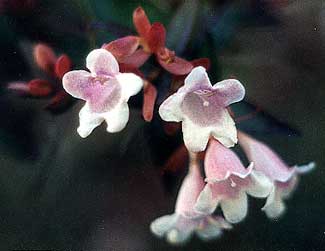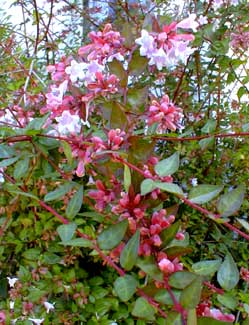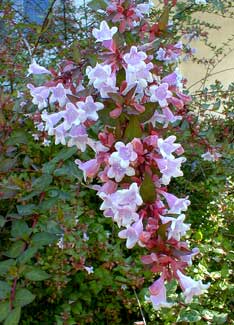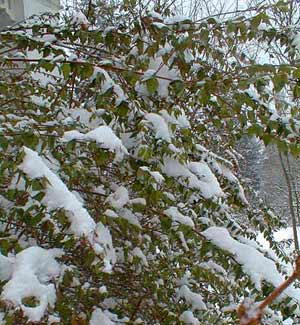
|
Ed Goucher's Abelia |
Abelia is named for Dr. Clark Abel (1780-1826), a British physician & naturalist to Lord Amherst's embassy to China. Dr. Abel introduced Abelia chinensis to western gardening in the old days of the most famed Plant Explorers. He published a marvelous travelogue in 1818, entitled Narrative of a Journey into the Interior of China & of a Voyage to & from that Country in the years 1816 & 1817, including his journeys to Korea & the Philippines, illustrated with exquisite color plates. A nice copy of this book is today worth thousands of dollars.
 Our garden's Abelia is a cross between A. grandifolia & A. schumannii, hybridized by Edward Goucher at the USDA Station in Glen Dale, Maryland, in 1911. The Glen Dale station is famed for rhododendron hybrids too. A. grandifolia was itself a hybrid of two Chinese species, Dr. Abel's original A. chinensis pollinated by A. uniflora.
Our garden's Abelia is a cross between A. grandifolia & A. schumannii, hybridized by Edward Goucher at the USDA Station in Glen Dale, Maryland, in 1911. The Glen Dale station is famed for rhododendron hybrids too. A. grandifolia was itself a hybrid of two Chinese species, Dr. Abel's original A. chinensis pollinated by A. uniflora. The Edward Goucher hybrid still resembles A. grandifolia, the Glossy or Smooth Abelia. The easiest way to tell Smooth Abelia from Edward Goucher is from the leaves which are rather bumply on the Goucher, but unrumpled on the Smooth Abelia. When in bloom, the Smooth Abelia has white flowers, as opposed to the pale violet-pink of Edward Goucher. If you look awfully close at these nearly scentless blossoms, there is orange down in the throat.
But the reason I personally was so easily able to identify this old shrub for its specific cultivar is because when I was cleaning up & weeding under it some years ago, I happened to dig up a faded brittle garden tag that some past owner of the house seems to have stuck in the ground beside it & which got buried under a semi-wild patch of Grape Hyacinths. Finding the tags always makes identification a cinch!
 This Abelia is three-fourths to fully evergreen in our yard, even though it has the delicately chaotic & fountaining appearance of a deciduous shrub. The fourth photo below shows our Abelia after a snowfall in January, its fully leafed branches weighted over. The small fine lacy leaves have red in them much of the year. The newest spring leaves emerge bronze then fade to a normal green. But then the leaves become purplish in autumn, & remain that color thereafter.
This Abelia is three-fourths to fully evergreen in our yard, even though it has the delicately chaotic & fountaining appearance of a deciduous shrub. The fourth photo below shows our Abelia after a snowfall in January, its fully leafed branches weighted over. The small fine lacy leaves have red in them much of the year. The newest spring leaves emerge bronze then fade to a normal green. But then the leaves become purplish in autumn, & remain that color thereafter.The blooms are small deep funnels in colors of pink & white & lilac beginning June, reblooming continuously until deep into Autumn. The first photo above was snapped in July (2001), & the other two photos are from September (2003). In October the branches are always still just full of blooms. There will be an occasional & unexpected vagrant bloom here & there amidst the branches even in December & January. So it is as nearly everblooming as any shrub we have.
Edward Goucher Abelia is usually only about five or six feet high, but ours is very old & not often pruned & stands at eight feet tall. The biggest Edward Goucher Abelias do sometimes reach ten or eleven feet. If we took the fountaining branches on ours & lifted them fully upright, it would be as big as the biggest.
 It can go years unpruned & still flower very well, but at some point it will be using too much of its energy to sustain the dense chaos of limbs & twigs, & won't bloom so densely. Eventually we did have to do some deep spring pruning to thin it out, taking the rangier older branches out of the shrub as near the base as we could reach, striving to keep enough of the longest branches that it wouldn't look cropped. The thinning resulted in a particularly showy flowering the rest of the year.
It can go years unpruned & still flower very well, but at some point it will be using too much of its energy to sustain the dense chaos of limbs & twigs, & won't bloom so densely. Eventually we did have to do some deep spring pruning to thin it out, taking the rangier older branches out of the shrub as near the base as we could reach, striving to keep enough of the longest branches that it wouldn't look cropped. The thinning resulted in a particularly showy flowering the rest of the year.This shrub will be evergreen to semi-deciduous at temperatures as low as 15 degrees; at zero degrees, however, it becomes the sort of perennial that dies to the ground, so will never grow to its potential maximum size even though still thriving with the behavior of a perennial subshrub. In field tests for cold hardiness, Edward Goucher grew back from the ground at temperatures to minus 1, so it is less cold hardy than A. grandifolia that grew back from minus fifteen. Fortunately Puget Sound weather is just within the boundary for it to be evergreen, as we rarely have temperatures into the teens, & severe cold-snaps are even more rarely sustained for any length of time.
Abelia likes peaty soil & a lot of sun. Ours gets plenty of afternoon sun. It would also grow well in shade but wouldn't bloom well & would get leggy. It is liked by butterflies & is drought tolerant; ours being so long established, it asks no watering at all, getting by with the Northwest's very adequate rainfall & not suffering during our summers' dryness. I'd rate this one of the highest quality shrubs for the Northwest, & am very surprised to see in so many Northwest gardens that Weigela & Escallonia so outnumber Abelia.